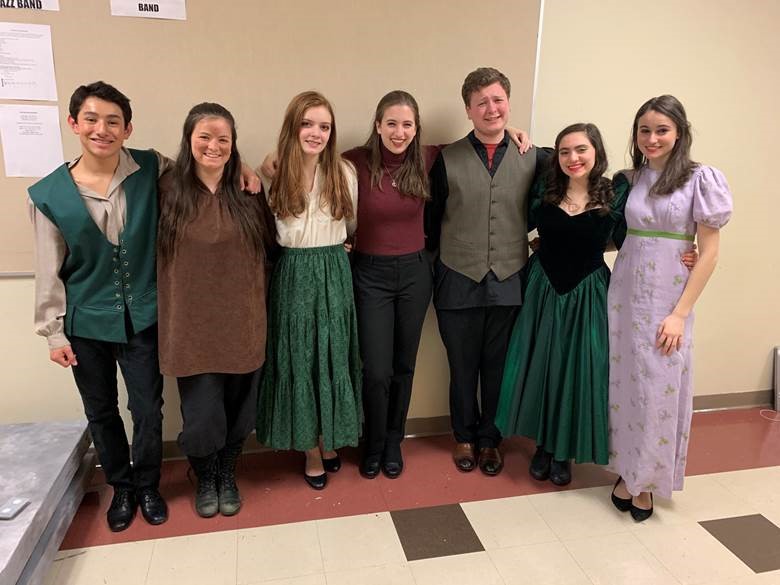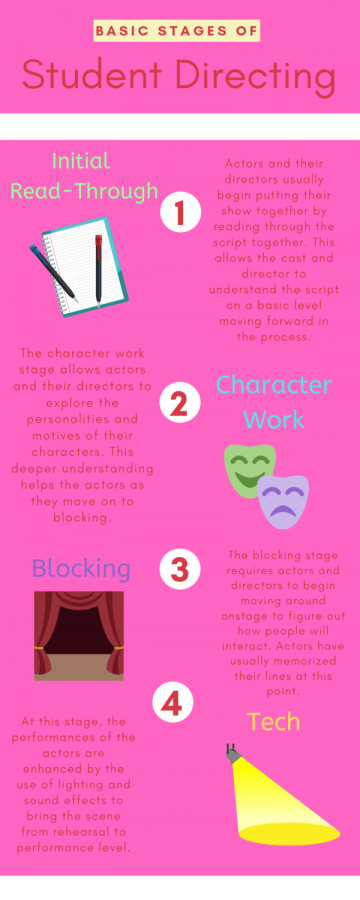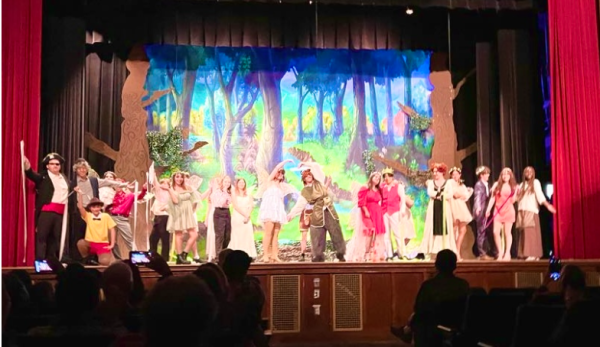From rehearsal to performance
Photo Credit: Madelyn Willoughby
The cast of Rapunzel poses with their student director, Isabel Siggers. Siggers is a senior and a member of the Theatre Company Executive Board and was excited to take on her role as a student director for “Wicked and Whimsical.”
The most exciting part of student directing for Isabel Siggers was being able to see her play come alive on stage after many rehearsals. She loved to see her actors take just a little bit of her direction and make it into a live action show with lots of small details and interaction. She loved the moment when her Rapunzel script became a show.
The spring scenes of 2019, “Wicked and Whimsical,” took place on April 4, 5, and 6. The production was sourced from the brothers Grimm fairy tales but was divided into six scenes with a twist. All of the scenes were related as one play, but each was a distinct fairy tale with its own characters and actors.
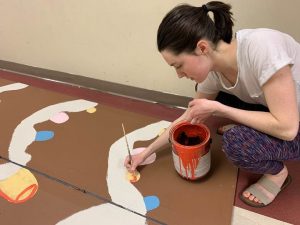
Senior Zoe Shea paints flats to be used as one of the set pieces in Hansel and Gretel, one of the small scenes of “Wicked and Whimsical.” Shea is a member of the Theatre Company Executive Board and has been acting with the Theatre Company since her freshman year. Shea also designed the poster for “Wicked and Whimsical” and the illustrations displayed in the auditorium and display case.
Each year, seniors who have been participating in the Theatre Company for a long time are invited to apply to be a student director who leads one of the scenes. This year the scenes were Rapunzel, Hansel and Gretel, Talking Fish, Snow White, Little Red Riding Hood, and Cinderella. The student directors were Siggers, Emily Campbell, Dylan Needleman, Free Alter, Jess Peiser, and Ethan McNamara.
Siggers directed Rapunzel, a play that follows the stories of both Rapunzel and Rumpelstiltskin as Rapunzel’s mother makes deals with multiple supernatural beings. However, once the child is grown up, the mother realizes that she has made deals with too many beings for the same price: her daughter. Rapunzel is then taken away from her mother and father to live in a tower without stairs or a door, occasionally visited by the evil Enchantress that locked her there.
Siggers is an executive board member, actor, and student director for the Theatre Company. She began acting with the Theatre Company as a freshman, starting with “The Matchmaker” her freshman year and continuing all throughout high school until “Pride and Prejudice,” at the start of her senior year. Though she had always been an actor in the Theatre Company performances, she had previously helped with other aspects of the show and wanted to explore more behind the scenes positions. She was inspired to apply to be a student director for “Wicked and Whimsical” because she has always been fascinated with the inner workings of theatre that go beyond the actors alone. She also felt that her creative control would help create an entertaining show.
“To put on a live action show in front of an audience,” Siggers said, “I mean that’s kind of insane if you really think about what it takes.”
Siggers began the process of applying to be a director by attending a meeting hosted by Theatre Company adviser and English and Theatre teacher Juliet Montalbano. In this meeting, Montalbano described the position and the time commitment connected with it. After signing a
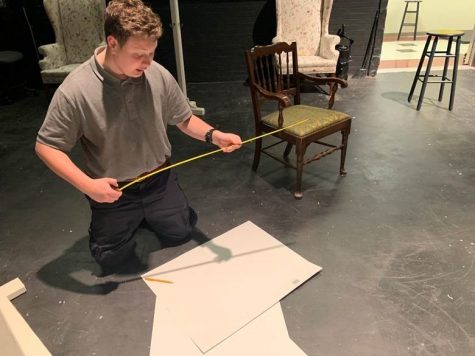
Senior Andrew Bober measures poster paper to be used on one of the set pieces of “Wicked and whimsical.” Bober is a member of the Theatre Company Executive Board and he is an actor. He worked on set pieces with the rest of the cast and crew on the Saturday the week before the show.
contract and writing a short essay about why she wanted to be a student director, Siggers was accepted and began working on her scene.
Junior, Sofia Karras, acted as Little Red Riding Hood and was excited to work with her director, Jess Peiser, on this scene. Karras is on the Theatre Company Executive Board and has worked on the decorations in the display case in the auditorium lobby, the Theatre Company clothing, as well as other jobs. Peiser is also on the Theatre Company Executive Board and has previously worked as the stage manager for the Theatre Company. Karras was excited to begin acting and working with her student director on Little Red Riding Hood.
“She’s good at answering any questions you might have,” Karras said. “She makes the rehearsal time super fun.”
Karras is on the Theatre Company Executive Board and has worked on the decorations in the display case in the auditorium lobby, the Theatre Company clothing, as well as other jobs. She has been acting in Theatre Company performances since the spring of her freshman year, and she has worked with many student directors in the past. During her freshman year she worked with student director, Bridget Darcy, and during her sophomore year she worked with Madie Jones.
Stages of Directing
While putting on a show includes many small steps, there are a few basic stages and categories of the process.
Read Through
Siggers made many realizations about her characters and the script during the first read through of Rapunzel. She began to recognize the humor of certain lines. For example, a line about Rapunzel’s prince being shorter than Rapunzel became funny after being spoken aloud by the actors.
The read through of the script is important because it helps the director and the actors begin to visualize the scene. This step helps the director of a production hear their script spoken aloud by the actors who will ultimately play the characters. This stage of rehearsal also allows the actors to see the script for the first time and begin to get to know their characters and their relationships with the other characters in the play. It prepares them for the major rehearsals that will follow.
Character Work
“If they don’t feel connected to their character, acting is going to be nearly impossible,” Siggers said. “Then nothing will come naturally to them and it will come off very awkward and stiff.”
The character work stage of putting on a show involves a read through type rehearsal in which the actors and the director speak about a character’s motives and personality. This helps the actors and the director have a better understanding of the characters and the reasoning behind their actions and words. This stage is fun for the participants because the actors and the director are able to brainstorm different ways that the character could be played. Additionally, actors and their directors may decide on different details about the characters: their names, possible accents, and other traits.
Siggers enjoyed this aspect of directing because she was able to allow her actors to connect with the personalities and motives of their characters.
“It really does help you get in the mindset of your character,” Karras said, “It really helps you understand what their aim is in this play and who they are.”
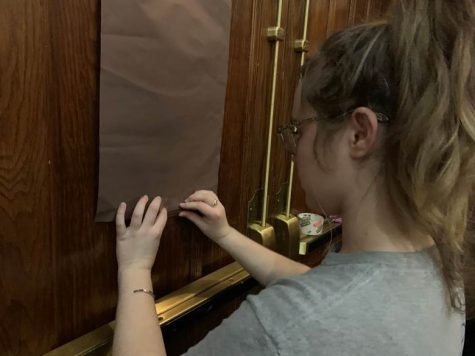
Junior Dylaney Sabino tapes paper over the windows of the auditorium to prevent light from coming into the auditorium and changing the lighting on stage. Sabino is a member of the Theatre Company Executive Board and has been acting with the Theatre Company since the beginning of her freshman year.
Blocking
An issue Siggers faced while putting Rapunzel together was the interaction of the characters with the tower that Rapunzel was locked in during the performance. Initially, Siggers wanted to make the tower a tall platform on the stage that actors would climb onto using a ladder that Rapunzel would cover with her hair. However, it became clear to Siggers that the use of a smaller platform would work better because actors would be able to more easily walk onto and off of it. As for climbing the hair, actors walked horizontally as if they were climbing up the tower.
This is the blocking stage. This helps the characters in a play begin to learn where they should stand on stage and how to interact with each other as they memorize their lines and get on their feet. This step allows the student directors and their actors to decide where the characters will be moving onstage as they put their scene together.
Siggers felt this stage helped her understand the scene in a new way as the actors began interacting with each other without their scripts.
“It’s essentially like diving into the deep end,” Siggers said. “I would give actors basic direction and then see what they naturally do.”
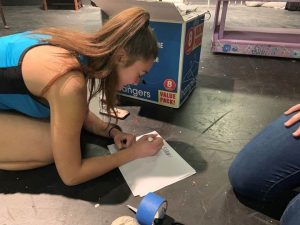
Junior Jess Rosen organizes labels for costumes that were used for “Wicked and Whimsical.” Rosen has been participating in the Theatre Company since the spring of her freshman year and is an actor and the head costume designer of the Theatre Company.
Tech
“When you add lights, curtain, sound, it really helps immerse the audience in the story,” Siggers said.
Once a scene has been blocked and rehearsed, the next stage is to prepare the technical aspects of the show: lights, sound, and other elements. Many directors see this step as another way to take a scene from rehearsal to performance because of the professional qualities it adds. Directors are able to decide on the lights that will appear on the stage during parts of the scene. For example, Siggers decided to change the lighting of her show when the actors “broke the fourth wall” and spoke directly to the audience.
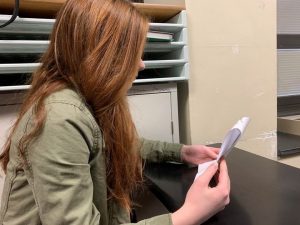
Madelyn Willoughby studies her lines before rehearsal for “Wicked and Whimsical.” Willoughby is a member of the Theatre Company Executive Board and is the head makeup artist of the Theatre Company.
Additionally, sound effects may be added to the scene. Sounds that appear in the script can be translated through the use of different sound effects by the crew members at the tech table. For example, Peiser’s Little Red Riding Hood involved the use of a beeping sound to imply that the actors were using foul language. For “Wicked and Whimsical,” actors Dylaney Sabino and Sofia Nolfo assisted the tech crew with sound effects due to a shortage of tech crew members.
In order to put these elements together, the entire cast and crew meet at the school the Sunday the week before the show. The director sits in the back with the tech crew members while actors stand onstage as placeholders so the directors can assess different lighting and sound options.
Leaving the Theatre Company
After spending four years performing and working with the Theatre Company, many of the student directors and other Theatre Company seniors are sad to leave their friends and Montalbano.
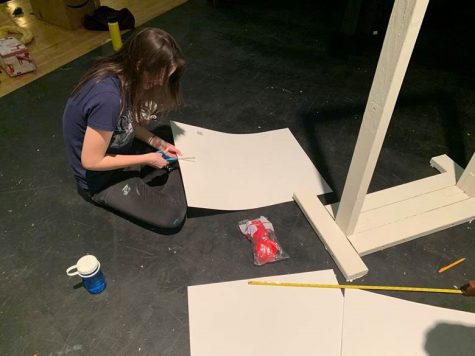
Senior Emily Campbell cuts poster board to be used as a set piece in “Wicked and Whimsical.” Campbell is a member of the Theatre Company Executive Board and the student director for Little Red Riding Hood. She wanted to direct this scene specifically because it involved major audience participation.
Karras said that she is sad to see the current seniors leave because she has known them for the longest. While she has had less time to get to know the seniors from previous years, she has had the opportunity to become closer with the current seniors because they are close in age.
“This is the third year I’ve done Theatre Company with them,” Karras said. “I’m really proud of all of them and you can really see how much they’ve grown.”
Siggers has been acting with the Theatre Company since her first year of high school, and she feels it is surreal that so much time has passed since then. She has especially been shocked by the feeling that she has become a leader of the Theatre Company with major influence among its members.
“This whole time I’ve been learning but now I’m teaching and moving on,” Siggers said. “It’s crazy, I still can’t believe it’s almost over.”

Madelyn Willoughby is a junior at Glen Rock High School and this is her second year working for the Glen Echo. In her free time she works with the Glen...



